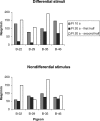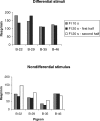Some effects of procedural variations on choice responding in concurrent chains
- PMID: 20514166
- PMCID: PMC2771668
- DOI: 10.1901/jeab.2009.92-345
Some effects of procedural variations on choice responding in concurrent chains
Abstract
The present research used pigeons in a three-key operant chamber and varied procedural features pertaining to both initial and terminal links of concurrent chains. The initial links randomly alternated on the side keys during a session, while the terminal links always appeared on the center key. Both equal and unequal initial-link schedules were employed, with either differential or nondifferential terminal-link stimuli across conditions. The research was designed to neutralize initial- and terminal-link spatial cues in order to gain a clearer understanding of the roles of conditioned reinforcement and delayed primary reinforcement in choice. With both equal and unequal initial links and with differential terminal-link stimuli, all pigeons reliably preferred the chain with the shorter terminal link. However, with equal initial links and nondifferential stimuli, all pigeons were indifferent. With unequal initial links and nondifferential stimuli, some pigeons were also indifferent, while others actually reversed and preferred the chain with the shorter initial link, even though it was followed by the longer terminal link. The decrease if not reversal of the previous preferences implies that preferences in concurrent chains are a function of the conditioned reinforcement afforded by terminal-link stimuli, rather than delayed primary reinforcement.
Keywords: choice; concurrent chains; conditioned reinforcement; delay of reinforcement; key peck; pigeons.
Figures









Similar articles
-
Dual effects on choice of conditioned reinforcement frequency and conditioned reinforcement value.J Exp Anal Behav. 2010 Mar;93(2):147-55. doi: 10.1901/jeab.2010.93-147. J Exp Anal Behav. 2010. PMID: 20885807 Free PMC article.
-
Effects of primary reinforcement on pigeons' initial-link responding under a concurrent chains schedule with nondifferntial terminal links.J Exp Anal Behav. 2001 Jul;76(1):75-94. doi: 10.1901/jeab.2001.76-75. J Exp Anal Behav. 2001. PMID: 11516116 Free PMC article.
-
Choice and conditioned reinforcement.J Exp Anal Behav. 1991 Mar;55(2):177-88. doi: 10.1901/jeab.1991.55-177. J Exp Anal Behav. 1991. PMID: 2037826 Free PMC article.
-
Acquisition of choice in concurrent chains: Assessing the cumulative decision model.Behav Processes. 2016 May;126:82-93. doi: 10.1016/j.beproc.2016.03.011. Epub 2016 Mar 19. Behav Processes. 2016. PMID: 27005579 Review.
-
The effect of conditioned reinforcement rate on choice: a review.J Exp Anal Behav. 2007 May;87(3):409-21. doi: 10.1901/jeab.2007.44-06. J Exp Anal Behav. 2007. PMID: 17575906 Free PMC article. Review.
Cited by
-
Getting it right: a reply to baum.Behav Anal. 2010 Fall;33(2):237-8. doi: 10.1007/BF03392224. Behav Anal. 2010. PMID: 22532720 Free PMC article.
References
-
- Colton L, Moore J. The effects of terminal-link stimulus arrangements on preferences in concurrent chains. Psychological Record. 1997;47:145–166.
MeSH terms
LinkOut - more resources
Full Text Sources

